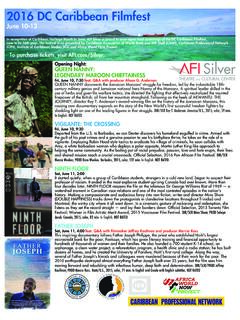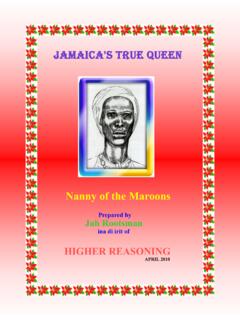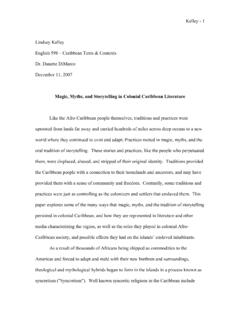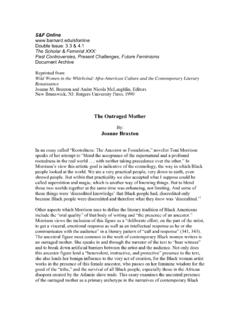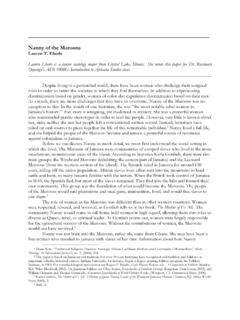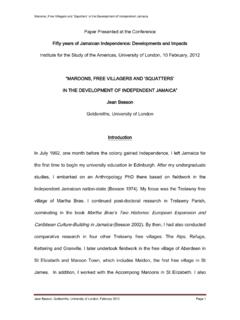Transcription of MAR 2014 - Irie™ Magazine
1 ROOTS / ROCK / REGGAE / RESPECTM A G A Z I N 2014 ISSUE #3 ETANATHE STRONG ONEGRANDY NANNYSAHRA INDIOAUNTIE REGGAE RECYCLE HAWAI ISHUGA S EBONY bonus TRAXJAH9 HEMPRESS SATIVA KELISSA SHUGA MIRIAM SIMONEZENNYMADDY CARTY BRITISH REGGAERESPECTREWIND REBEL SALUTE Strictly a reggae band, no. Definitely a reggae band, yes. - William Bunny Rugs ClarkeNicholas Nico Da SilvaFounder/PublisherISSUE #3 / MARCH 2014 Bart Henseler PhotographyWILLIAM BUNNY RUGS CLARKEREST IN PEACE, DEAR BROTHER!FEBRUARY 6, 1948 FEBRUARY 2, 2014 Grandy NannyNanny of the MaroonsSahra IndioAuntie ReggaeEtanaThe Strong OneKindahSistrenDanny CreatahWorld A ReggaeDoobieSoundFyah Watah RiddimTABLE OF NannyNanny of the of 4 GRANDY NANNYBy Kam-Au AmenNanny of the MaroonsI ve thought for a while about the angle I would take to this story of Jamaica s only heroine, nanny of the Maroons as she s officially called, even while the Maroons of Jamaica often refer to her as Grandy nanny or Queen nanny .
2 As to why she is called nanny , some have indicated that it could be an Anglicization of the Asante title Nana , accorded to elders as an indication of are hardly any new facts I can bring to nanny s legendary story, nevertheless I believe her story has some significance for us in this time. At this point in our history we are called upon to continue the African struggles in the Caribbean and the Americas for not only our survival but also our prosperity as African people. The story of nanny of the Maroons is one of survival and this should be one of the key lessons we take away as we encounter her story; her triumphs and her losses. The accounts surrounding her are somewhat a mix of myth and fact that seek to give us insight into why she did what she did, but there can be little doubt around the fact that her struggles were about survival. That is, her survival and that of her community who found themselves marooned in Jamaica, victims of the European slave trade, for the most part, if not explorers in their own right, as professor Ivan Van Sertima has revealed to us in his own writings of the African presence in the Caribbean and the Americas before Christopher Columbus.
3 We re the survivors, yes: the Black survivors! BOB MARLEY, of 4 nanny , who was likely an ethnic Akan/Asante woman, was named a national hero in Jamaica in 1975, a period when the post-colonial Caribbean nation was fighting to establish its own independent identity. This was all part of a movement to reorient the young nation to the brave action of some of its past freedom fighters, and to establish a pantheon of its own to challenge the heroes and the values European enslavement and colonialism had left with its people. The success of these efforts may still be debated. But, very few can argue against the fact that Jamaican ideas about the modern world that were crystallized in the movements of Marcus Garvey, Rastafari and some radical activists, have, through Jamaican music, given the nation a distinctly international African diaspora identity. Maybe this was not what nanny envisioned, but we know for sure that her struggles to survive helped in making this reality to the Jamaica Information Service s website, the official Jamaica government news agency, it declares that, nanny was a leader of the Maroons at the beginning of the 18th century.
4 Both the Maroons and the British settlers knew her as an outstanding military leader who became, in her lifetime and after, a symbol of unity and strength for her people during times of crisis. She was particularly important to them in the fierce fight with the British, during the First Maroon War from 1720 to 1739. nanny , is described in this account as having exceptional leadership qualities and was physically a wiry woman with piercing eyes. It documents that, her influence over the Maroons was so strong, that it seemed to be supernatural and was said to be connected to her powers of obeah. She was particularly skilled in organizing the guerilla warfare carried out by the Eastern Maroons to keep the British troops who attempted to penetrate the mountains to overpower them. Further, Grandy nanny was also presented as a type of chieftain or wise woman of the village, who passed down legends and encouraged the continuation of customs, music and songs, that had come with the people from Africa, and which instilled in them confidence and pride.
5 Her militancy has been noted by her disagreement, when Quao signed the second Treaty (the first was signed by Cudjoe for the Leeward Maroons a few months earlier) with the British, as nanny saw this move as a form of subjugation. What seems very clear from all the accounts is that nanny was relentless in her struggle to maintain freedom and independence from British is therefore quite understandable the reasons for making nanny a national hero at the time when the young Jamaican nation needed to make a bold statement about breaking away from colonial domination and economic oppression. Having achieved political independence in 1962, the nation still needed to make bold strides to show that it had its sovereign right to also determine its own socio-cultural and economic destiny. I have argued elsewhere, that this sovereign self-determination was more than the traditional resistance to enslavement and white domination, but more of a struggle of survival and cultural projection to be themselves on their own African terms, which, in reality, was the only terms they knew.
6 Resistance theory has got a lot of traction on this account, but I ve been skeptical of its ability to fully explain the entire African experience in the Caribbean. Particularly, since I believe that there were many Africans in the West who were busy structuring their fractured lives in ways that they had been familiar, and less so concerned about resistance. In other words, their lives in the West, rather than being totally consumed by resistance to European oppression, were first continuations of their African experiences, overlaid with new Caribbean and American experiences. The irony this position reveals is that in that state of being the Africans knew, their position emerged as the greatest heights of resistance that could be achieved. This brings to mind one of dub poet Mutabaruka s timeless 3 of The important thing then is to stay alive; If you do you will outlive your present Besides, if you survive, who knows?
7 It may be your turn to eat tomorrow. Your son may bring home your share. quotes: the best way to preserve your culture is to live your culture . There is hardly an argument there against that in my view. Much may be made of the fact that nanny happened to be a woman. And, there is little doubt that an analysis of her impact may be pursued along gendered lines. Influential matriarchs are not unusual figures in many West African societies and the influence of the matriarch in modern Jamaican society continues to the present day, and sociological studies of the day will attest. Therefore, it is only fitting that nanny be included in Jamaica s list of heroes, and the truth be told, if power were balanced nanny would likely not be the sole female in the we pause to consider the legacy of nanny among the Maroons, the wider Jamaican society, and our international brothers and sisters in the struggle to assert and live their African identity, we can truly find empowerment in the legacy of Grandy nanny .
8 She recognized that it was important to fight and to stay alive for the good of herself and her community. True to form, nanny has proven herself to be a leader of the black survivors. And maybe if nanny were to say it her way, dispensing her motherly advice, she would probably have expressed it like the writer Chinua Achebe in his book A Man of the People: Whatever the manner in which it is expressed, the message is clear. Stay alive, because our prosperity will come tomorrow. Yes, we re the survivors. nanny of the Maroons JIS, nanny of the Maroons: History, Memory, and Imagery by Kimberly Juanita Brown, Yale University of 4 FOLLOWKam-Au IndioAuntie of 5 SAHRA INDIOBy Nicholas Da SilvaAuntie ReggaeI was first introduced to Sahra Indio s music in 2010. At the time, I was putting together the first in a series of reggae compilations to accompany my Dread & Alive comic book series. I don t remember exactly how I came across her music, but I do remember the song that caught my Jah Fire!
9 This reggae song was so infectious that I knew it had to be included in the first release. After connecting with Sahra, I began to listen to more of her music and soon discovered that each of her songs told a story, one full of deep meaning and with a lesson to be learned. And Jah Fire was no different. As I listened closely to the chorus of Jah Fire, it made me want to seek the truth behind the song. When I asked Sahra about the meaning behind the song, she quickly informed me that the track had been written in a short time, fueled by vexed emotions. She would go on to tell me that Jah Fire was a genuine plea to Jah to heal us all from our insecurities so that we could truly be unified! Sahra s music does that to you. She makes you want to seek the truth! But there s more to Sahra Indio than her music. Known as the Original Bush Mama, she lives off the grid in Hawaii and is considered a sustainable reggae artists.
10 I had the opportunity to meet up with Sahra on my trip to Hawaii. After a little island hopping, we manage to meet up in Kuaui to discuss her new role in Auntie Reggae! of 6 IRIE. Share with us the story behind the name Auntie Reggae?The name Auntie Reggae came from a youth in the audience after a performance. In Hawaii, it s customary to address one older than you as Auntie, (pronounced Antie) or Uncle. The name suited me perfectly and I started using, Auntie Reggae, for the school presentations. What a great name it turned out to be! Auntie Reggae, brings a smile to everyone s face and that s always a good In 2012, you joined Recycle Hawaii and began visiting schools to talk to students about the Zero Wast Concept and Sustainability. Can you tell us more about this? Ke Ola Magazine , a Magazine celebrating the arts, culture, and sustainability of the Hawaiian Islands, featured me in an article highlighting my recycle arts and music.
